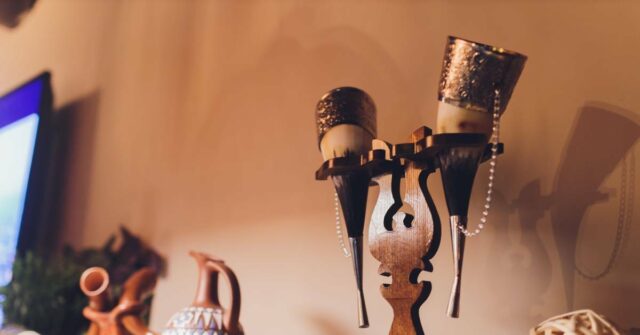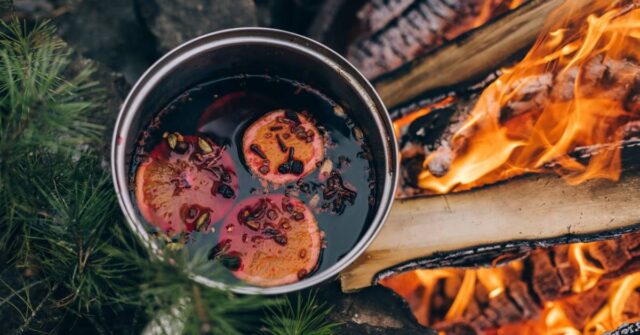Welcome to the comprehensive guide on caring for your drinking horn.
Whether you’re a seasoned collector or a newcomer intrigued by the allure of these historic vessels, this guide will provide you with all the necessary information to maintain, clean, and enjoy your drinking horn for years to come.
Introduction to Drinking Horns
Drinking horns have been a part of human history for centuries, spanning various cultures and periods. Traditionally made from the horns of bovines, they have been used for ceremonial purposes and daily use.
Understanding their history and types will enhance your appreciation and care for these unique items.

History and Significance
The use of drinking horns dates back to ancient civilizations, including the Norse, Greeks, and Romans.
They were often symbols of power and status and were intricately decorated for those of high social standing.
Today, they are popular among history enthusiasts and those who appreciate their rustic aesthetic.
Types of Drinking Horns
Drinking horns come in various shapes and sizes, from simple, unadorned ones to elaborately carved and decorated pieces.
The type of horn (cow, buffalo, etc.) and its treatment (polished, engraved, etc.) can affect its care and maintenance.
Choosing the Right Horn for You
When selecting a drinking horn, consider its size, craftsmanship, and material. Each horn is unique, so choose one that feels right for you, whether for display or practical use.
Initial Preparation and Cleaning
Your new drinking horn requires proper preparation and cleaning before its first use. This initial care is crucial to ensure its longevity and enjoyment.

Sanitizing Your New Drinking Horn
Before using your horn, it’s essential to sanitize it. You can do this by washing it with mild soap and warm water. Avoid hot water as it can damage the horn.
Removing Natural Odor
Horns may have a natural odor when new. This can be reduced by soaking the horn in a mixture of warm water and baking soda for a few hours, then rinsing thoroughly.

2.7lb Baking Soda in Resealable Bag
Remove odours from your drinking horn with ARM & HAMMER Baking Soda. Pure, natural, and versatile, it’s perfect for cleaning and deodorizing. Trusted, eco-friendly, and made in the USA.
Handling and Storage Guidelines
Handle your horn with care, avoiding drops or harsh impacts. Store it in a cool, dry place, away from direct sunlight and extreme temperatures to prevent warping or cracking.
Regular Maintenance and Care
Regular maintenance is key to preserving the integrity and appearance of your drinking horn.
Cleaning After Use
After each use, rinse the horn with warm water and dry it with a soft cloth. Avoid using dishwashers or harsh detergents as they can damage the horn’s surface.
Drying and Moisture Prevention
Ensure your horn is completely dry before storing it to prevent mold and mildew growth. Store it in a vertical position to allow any residual moisture to evaporate.
Polishing and Aesthetic Maintenance
Polish your horn periodically with food-safe oil, such as mineral oil, to maintain its shine and prevent drying out.

Food Grade Mineral Oil for Premium Protection
Revitalize your drinking horns with this food-safe mineral oil. Also perfect for wood care and cooking products, it protects and conditions, ensuring longevity.
Avoiding Common Damages
Understanding what can damage your horn will help you avoid common pitfalls in its care.
Temperature and Environmental Factors
Extreme temperatures and humidity can warp or crack the horn. Avoid leaving it near heat sources or in overly humid environments.
Chemicals and Cleaners to Avoid
Avoid using abrasive cleaners, bleach, or strong detergents on your horn. These can strip away natural oils and damage the horn’s surface.
Physical Handling and Impact Prevention
Be cautious with your horn. Dropping or knocking it against hard surfaces can cause cracks or chips.

Long-Term Preservation
Proper long-term care is essential for preserving your drinking horn, especially if it’s part of a collection or holds sentimental value.
Seasonal Care Tips
With changing seasons, adjust your care routine. In drier months, you may need to oil your horn more frequently to prevent cracking.
Storing Your Horn for Extended Periods
If storing your horn for an extended period, ensure it’s clean, dry, and lightly oiled. Store it in a breathable bag in a stable environment to protect it from dust and fluctuations in temperature and humidity.
Reviving an Old or Neglected Horn
To revive an old or neglected horn, gently clean it with a mild soap solution, treat any visible cracks, and rehydrate it with mineral oil. This can restore some of its former glory and functionality.

8 Pack Bottle Brush Horn Cleaning Set
Keep your drinking horns pristine with these versatile bottle cleaning brushes. Includes brushes for all sizes and shapes, ensuring a gentle yet thorough clean every time.
Enhancing Your Drinking Horn Experience
Your drinking horn is not just a vessel; it’s a piece of history and art. Enhancing your experience with it can make it even more enjoyable.
Customizing Your Horn
Consider customizing your horn with engravings or decorative elements that reflect your personal style or heritage. However, ensure that any customization is done using methods that do not damage the horn.
Pairing with Beverages
Drinking horns are traditionally used for mead, but they can be used for any beverage. Consider the beverage’s acidity and temperature, as these can affect the horn’s interior.

Drinking Horn Etiquette and Traditions
Learn about the historical etiquette and traditions associated with drinking horns. This can enrich your experience and respect the cultural significance of your horn.
Troubleshooting Common Issues
Despite your best efforts, you may encounter some common issues with your drinking horn. Here’s how to address them.
Repairing Cracks and Leaks
If your horn develops cracks or leaks, you can often repair them with food-safe epoxy. Ensure the horn is clean and dry before applying any adhesive.
Addressing Discoloration
Discoloration can occur over time. Regular cleaning and oiling can help, but some natural patina can be a sign of your horn’s age and history.
Odor Management
If an odor persists, regularly clean your horn and ensure it’s thoroughly dried. Storing it with a mixture of baking soda inside can help neutralize odors.
Conclusion: Enjoying Your Drinking Horn Responsibly
With the right care and respect, your drinking horn can be a cherished item for years to come.
Remember to use and maintain it responsibly, and you’ll have a piece of history that continues to bring joy and intrigue.

Summarizing Key Care Tips
In summary, regular cleaning, proper storage, and avoiding extreme temperatures and harsh chemicals are key to maintaining your drinking horn. Treat it with care, and it will serve you well.
Further Resources and Reading
For more information, consider exploring historical texts about drinking horns, joining online communities of enthusiasts, or visiting museums with historical collections.
Joining the Community of Horn Enthusiasts
Joining a community of like-minded enthusiasts can provide support, advice, and enhance your overall experience with your drinking horn.











